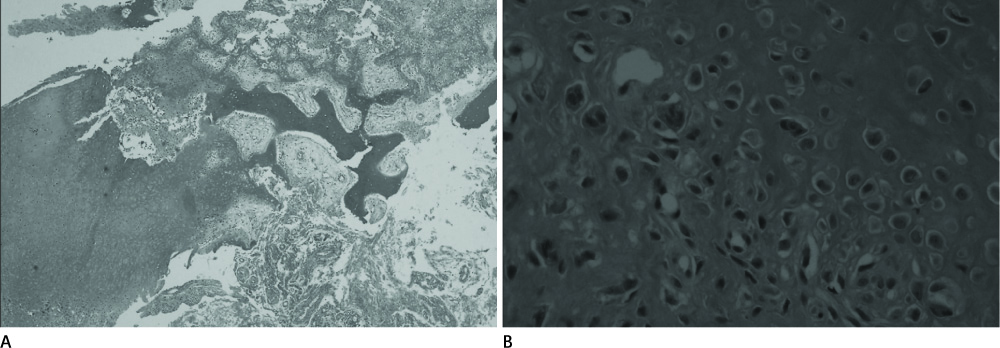J Korean Soc Radiol.
2011 Oct;65(4):415-419. 10.3348/jksr.2011.65.4.415.
Bizarre Parosteal Osteochondromatous Proliferation with Cortical Erosion in the Hand: A Case Report
- Affiliations
-
- 1Department of Radiology, Inje University College of Medicine, Ilsan Paik Hospital, Goyang, Korea. kyh@paik.ac.kr
- KMID: 2002945
- DOI: http://doi.org/10.3348/jksr.2011.65.4.415
Abstract
- Bizarre parosteal osteochondromatous proliferation (BPOP) is a rare osseous lesion occurring in the long bones of distal extremities. Typical imaging findings of BPOP show a well-defined calcified osseous mass without soft tissue swelling, cortical destruction, and medullary involvement. We experienced rare aggressive magnetic resonance imaging findings of BPOP with cortical erosion, bone marrow edema, and adjacent soft tissue enhancement, which was misdiagnosed as a malignancy or inflammatory lesion.
Figure
Cited by 1 articles
-
Diagnosis and Treatment of Bizarre Parosteal Osteochondromatous Proliferation
Duk-Seop Shin, Han Seok Yang, Ho Dong Na, Seung Min Ryu
J Korean Orthop Assoc. 2018;53(1):58-65. doi: 10.4055/jkoa.2018.53.1.58.
Reference
-
1. Torreggiani WC, Munk PL, Al-Ismail K, O'Connell JX, Nicolaou S, Lee MJ, et al. MR imaging features of bizarre parosteal osteochondromatous proliferation of bone (Nora's lesion). Eur J Radiol. 2001; 40:224–231.2. Soon JL, Chang HC, Sim CS, Teoh LC, Low CO. A case of Bizarre Parosteal Osteochondromatous Proliferation of the hand. Singapore Med J. 2003; 44:27–30.3. Joseph J, Ritchie D, MacDuff E, Mahendra A. Bizarre parosteal osteochondromatous proliferation: a locally aggressive benign tumor. Clin Orthop Relat Res. 2011; 469:2019–2027.4. Murphey MD, Choi JJ, Kransdorf MJ, Flemming DJ, Gannon FH. Imaging of osteochondroma: variants and complications with radiologic-pathologic correlation. Radiographics. 2000; 20:1407–1434.5. Helliwell TR, O'Connor MA, Ritchie DA, Feldberg L, Stilwell JH, Jane MJ. Bizarre parosteal osteochondromatous proliferation with cortical invasion. Skeletal Radiol. 2001; 30:282–285.6. Ly JQ, Bui-Mansfield LT, Taylor DC. Radiologic demonstration of temporal development of bizarre parosteal osteochondromatous proliferation. Clin Imaging. 2004; 28:216–218.7. Meneses MF, Unni KK, Swee RG. Bizarre parosteal osteochondromatous proliferation of bone (Nora's lesion). Am J Surg Pathol. 1993; 17:691–697.8. Yuen M, Friedman L, Orr W, Cockshott WP. Proliferative periosteal processes of phalanges: a unitary hypothesis. Skeletal Radiol. 1992; 21:301–303.9. Sakamoto A, Imamura S, Matsumoto Y, Harimaya K, Matsuda S, Takahashi Y, et al. Bizarre parosteal osteochondromatous proliferation with an inversion of chromosome 7. Skeletal Radiol. 2011; 40:1487–1490.10. Choi JH, Gu MJ, Kim MJ, Choi WH, Shin DS, Cho KH. Fibrosarcoma in bizarre parosteal osteochondromatous proliferation. Skeletal Radiol. 2001; 30:44–47.11. Michelsen H, Abramovici L, Steiner G, Posner MA. Bizarre parosteal osteochondromatous proliferation (Nora's lesion) in the hand. J Hand Surg Am. 2004; 29:520–525.
- Full Text Links
- Actions
-
Cited
- CITED
-
- Close
- Share
- Similar articles
-
- Parosteal Lipoma Associated with Underlying Recurrent Bizarre Parosteal Osteochondromatous Proliferation (Nora's Lesion) of the Hand
- Bizarre Parosteal Osteochondromatous Proliferation of Middle Phalanx: A Case Report
- A Case of Subungual Bizarre Parosteal Osteochondromatous Proliferation of the Toe
- Bizarre Parosteal Osteochondromatous Proliferation: A Report of One Case
- Aberrant Chromosomal Alterations in Bizarre Parosteal Osteochondromatous Proliferation (Nora's Lesion) of Hand: A Case Report




